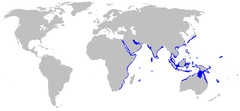Tawny nurse shark
| Tawny nurse shark | |
|---|---|
 |
|
| Scientific classification | |
| Kingdom: | Animalia |
| Phylum: | Chordata |
| Class: | Chondrichthyes |
| Subclass: | Elasmobranchii |
| Order: | Orectolobiformes |
| Family: | Ginglymostomatidae |
| Genus: |
Nebrius Rüppell, 1837 |
| Species: | N. ferrugineus |
| Binomial name | |
|
Nebrius ferrugineus (Lesson, 1831) |
|
 |
|
| Range of the tawny nurse shark | |
| Synonyms | |
|
Ginglymostoma muelleri Günther, 1870 |
|
Ginglymostoma muelleri Günther, 1870
Ginglymostoma rueppellii Bleeker, 1852
Nebrius concolor Rüppell, 1837
Nebrius doldi Smith, 1953
Nebrodes concolor ogilbyi Whitley, 1934
Nebrodes macrurus Garman, 1913
Scyllium ferrugineum Lesson, 1831
Scymnus porosus Ehrenberg, 1871
The tawny nurse shark (Nebrius ferrugineus) is a species of carpet shark in the family Ginglymostomatidae, and the only extant member of the genus Nebrius.
It is found widely along coastlines in the Indo-Pacific, preferring reefs, sandy flats, and seagrass beds from very shallow water to a depth of 70 m (230 ft). With a cylindrical body and a broad, flattened head, the tawny nurse shark is quite similar in appearance to the nurse shark (Ginglymostoma cirratum) of the Atlantic and East Pacific, from which it can be distinguished by its pointed-tipped dorsal fins and narrow, sickle-shaped pectoral fins. The maximum recorded length of the tawny nurse shark is 3.2 m (10 ft).
Nocturnal in habits, the tawny nurse shark tends to spend the day resting in piles of two dozen or more individuals inside caves or under ledges. At night, it is an active-swimming predator that uses a powerful suction force to extract prey from inside holes and crevices. The diet of this species consists mainly of octopus, though they also take other invertebrates, small bony fishes, and rarely sea snakes. It is aplacental viviparous, meaning the embryos hatch from egg capsules inside the mother. It is the only carpet shark in which the embryos are oophagous, feeding on eggs produced by the mother while inside the uterus. The litter size may be as small as one or two, based on the large size of near-term embryos.
...
Wikipedia

